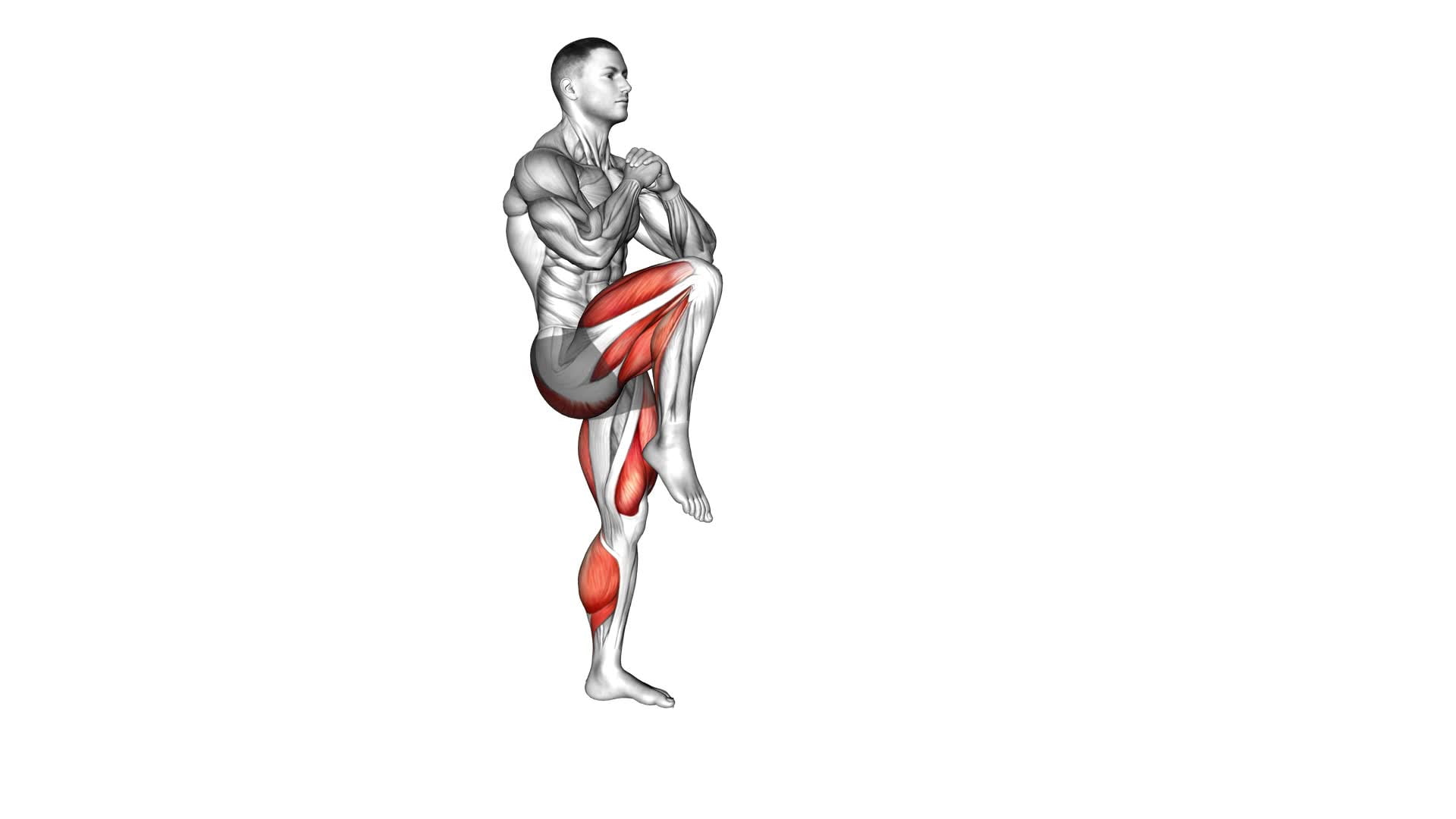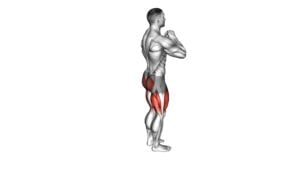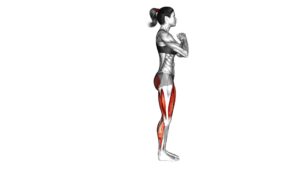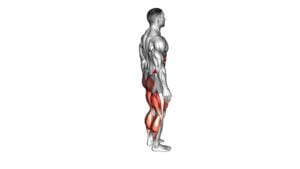Reverse Lunge High Knee Forward Lunge (male) – Video Exercise Guide & Tips

Are you looking for an effective lower body exercise that targets multiple muscles and improves your balance? Look no further than the reverse lunge high knee forward lunge!
Watch This Exercise Video
This video exercise guide and tips will show you the proper form and technique to maximize your results.
Avoid common mistakes, try different variations, and follow our expert tips for a more effective workout.
Get ready to elevate your fitness routine with this challenging and rewarding exercise.
Key Takeaways
- Reverse Lunge High Knee Forward Lunge improves lower body strength, stability, and balance.
- Engaging quadriceps, hamstrings, glutes, and calves, it tones and strengthens muscle groups.
- Proper form and technique are crucial to avoid common mistakes and maintain good alignment and posture.
- Variations and progressions can be incorporated to increase intensity, challenge muscles, and enhance strength and stability.
Benefits of Reverse Lunge High Knee Forward Lunge
You will experience multiple benefits from incorporating the Reverse Lunge High Knee Forward Lunge into your workout routine. This exercise is a great way to improve your lower body strength, stability, and balance. By performing this movement, you're engaging your quadriceps, hamstrings, glutes, and calves, which helps to tone and strengthen these muscle groups.
One of the key benefits of the Reverse Lunge High Knee Forward Lunge is that it allows for progressions. As you become more comfortable with the exercise, you can increase the difficulty level by adding weights or performing the movement at a faster pace. This enables you to continually challenge your muscles and prevent plateaus in your fitness journey.
Another advantage of this exercise is that it can be incorporated into interval training. Interval training involves alternating periods of high-intensity exercise with periods of rest or lower intensity. By adding the Reverse Lunge High Knee Forward Lunge to your interval training routine, you can elevate your heart rate and burn more calories in a shorter amount of time.
In summary, the Reverse Lunge High Knee Forward Lunge offers a variety of benefits, including improved lower body strength, stability, and balance. It also allows for progressions and can be incorporated into interval training for added cardiovascular benefits.
Proper Form and Technique
To perform the Reverse Lunge High Knee Forward Lunge with proper form and technique, there are a few common mistakes to avoid. These include not maintaining proper alignment, rushing through the movements, and neglecting to engage your core muscles.
Common Mistakes to Avoid
To ensure proper form and technique, it's essential to avoid common mistakes when performing the Reverse Lunge High Knee Forward Lunge exercise. By avoiding these mistakes, you can prevent potential injuries and maximize the effectiveness of the workout.
One common mistake isn't maintaining proper alignment during the lunges, which can strain your knees and back. Make sure to keep your front knee directly above your ankle and your back knee aligned with your hip.
Another mistake is rushing through the exercise without focusing on stability and control. Take your time to engage your core muscles and maintain balance throughout the movement.
Lastly, avoid leaning forward or hunching your shoulders, as this can lead to poor posture and increased risk of injury. Stay upright and maintain a strong, stable position throughout the exercise.
Benefits of Proper Technique
Maintaining proper form and technique during the Reverse Lunge High Knee Forward Lunge exercise allows for optimal benefits and reduces the risk of injury. Here are four reasons why proper technique is important and how it can maximize your workout results:
- Muscle activation: Performing the exercise with proper technique ensures that the targeted muscles are effectively engaged. This leads to better muscle activation and development.
- Joint alignment: Proper technique helps to maintain proper alignment of the joints, reducing the stress placed on them. This minimizes the risk of joint pain or injury.
- Balance and stability: Correct form and technique improve your balance and stability during the exercise. This allows you to perform the movement with control and precision.
- Efficient calorie burn: Performing the Reverse Lunge High Knee Forward Lunge exercise with proper technique ensures that you're using the correct muscles and exerting the right amount of effort. This helps to maximize calorie burn and overall workout efficiency.
Common Mistakes to Avoid
Avoiding improper form is crucial when performing the Reverse Lunge High Knee Forward Lunge exercise. By understanding and avoiding common mistakes, you can reduce the risk of potential injuries and maximize the effectiveness of this exercise.
One common mistake to avoid is leaning too far forward during the lunge. This can put excessive strain on your knees and lower back, increasing the risk of injury. Instead, focus on keeping your torso upright and your core engaged throughout the movement.
Another mistake isn't stepping far enough back during the reverse lunge. This can limit the range of motion and decrease the activation of your glutes and hamstrings. Ensure that when stepping back, your front knee is directly above your ankle and your back knee is hovering just above the floor.
It's also important to avoid rushing through the exercise. Performing the Reverse Lunge High Knee Forward Lunge too quickly can compromise your form and increase the risk of injury. Take your time and focus on maintaining proper alignment and control throughout the movement.
Lastly, be mindful of your balance and stability. Avoid allowing your front knee to collapse inward or wobble side to side. Keep your weight evenly distributed between both legs and engage your core to maintain stability.
Variations and Progressions
To progress the Reverse Lunge High Knee Forward Lunge exercise, you can incorporate variations to challenge your muscles in different ways. Here are four variations and progressions to consider:
- Weighted Reverse Lunge High Knee Forward Lunge: Hold dumbbells or a barbell on your shoulders while performing the exercise. This added resistance will increase the intensity and help build strength in your lower body.
- Jump Reverse Lunge High Knee Forward Lunge: Instead of stepping back into the reverse lunge, explosively jump and switch legs in mid-air. This plyometric variation will enhance power and cardiovascular endurance.
- Curtsy Lunge High Knee Forward Lunge: Instead of stepping straight back into the reverse lunge, cross one leg behind the other in a curtsy motion. This variation targets the glutes and inner thighs more intensely.
- Walking Reverse Lunge High Knee Forward Lunge: Rather than staying in one spot, step back into a reverse lunge, bring your back foot forward, and immediately step into a forward lunge with the same leg. Continue walking forward, alternating legs. This variation adds a dynamic element to the exercise, challenging your balance and coordination.
Incorporating these variations and progressions into your workout routine will keep your muscles guessing and continuously challenge your strength and stability. Remember to start with proper form and gradually increase the difficulty as you progress.
Tips for a More Effective Workout
To have a more effective workout, it's important to focus on proper form. This means maintaining good posture, engaging the correct muscles, and avoiding any excessive strain or tension.
Incorporating interval training into your routine can also enhance the effectiveness of your workout by increasing the intensity and calorie burn. By alternating between periods of high intensity and rest, you can challenge your body and improve your overall fitness level.
Proper Form Importance
Maintain proper form throughout your workout to maximize effectiveness and prevent injury. Proper alignment is key to getting the most out of your exercise routine. Here are some important reminders to help you maintain proper form:
- Keep your back straight: Avoid rounding or arching your back, as this can strain your spine and lead to injury.
- Engage your core: Activate your abdominal muscles to stabilize your body and maintain balance.
- Watch your knees: Keep them aligned with your toes to prevent unnecessary stress on your joints.
- Control your movements: Avoid swinging or jerking motions, and focus on smooth and controlled movements for better results.
Incorporating Interval Training
To maximize the effectiveness of your workout and achieve better results, incorporate interval training into your routine. Interval training involves alternating between high-intensity exercises and periods of rest or lower intensity. This type of training helps to increase your overall fitness level, burn more calories, and improve your cardiovascular endurance.
When incorporating interval training into your reverse lunge high knee forward lunge workout, you can add weights to challenge your muscles even more. Holding dumbbells or using a weighted vest during the lunges will increase the resistance and help build strength.
For beginners, it's important to start slowly and gradually increase the intensity and duration of your intervals. You can modify the workout by reducing the number of repetitions or using lighter weights until you feel comfortable and confident.
By incorporating interval training and adjusting it to your fitness level, you can make your reverse lunge high knee forward lunge workout more effective and achieve your fitness goals faster.
Now, let's move on to the next section and explore a sample reverse lunge high knee forward lunge workout.
Sample Reverse Lunge High Knee Forward Lunge Workout
Start by performing the reverse lunge high knee forward lunge exercise in your workout routine. This compound movement targets multiple muscle groups, helping you build strength and improve balance.
Here's a sample workout incorporating the reverse lunge high knee forward lunge:
- Warm-up: Start with 5 minutes of light cardio to get your blood flowing and muscles warmed up.
- Reverse Lunge High Knee Forward Lunge: Perform 3 sets of 10 reps on each leg. Start by stepping back into a reverse lunge, then bring your back leg forward and drive your knee up towards your chest. Step forward into a forward lunge, then repeat on the other leg.
- Dumbbell Shoulder Press: Grab a pair of dumbbells and perform 3 sets of 12 reps. Stand with your feet shoulder-width apart, hold the dumbbells at shoulder height, and press them up overhead.
- Plank: Finish off with a plank to engage your core. Hold the plank position for 30 seconds to 1 minute.
Remember to listen to your body and modify the exercises if needed. You can decrease or increase the weights, adjust the range of motion, or take breaks as necessary. Stay consistent with your workouts and gradually increase the intensity to see progress over time.
Frequently Asked Questions
Are There Any Modifications or Alternatives for Individuals With Knee or Joint Issues?
If you have knee or joint issues, it's important to find modifications or alternatives for exercises that may aggravate your condition.
When it comes to the Reverse Lunge High Knee Forward Lunge, there are a few options you can consider.
Instead of performing a full lunge, you can try a partial lunge or even a step-up exercise.
These modifications can help reduce stress on your knees and joints while still allowing you to work on your lower body strength and stability.
How Many Sets and Reps Should I Perform for a Reverse Lunge High Knee Forward Lunge Workout?
To get the most out of your reverse lunge high knee forward lunge workout, it's important to consider the number of sets and reps.
Start by performing 3-4 sets of 8-12 reps on each leg. This will help build strength and endurance.
Remember to focus on proper form for reverse lunge variations, keeping your back straight and core engaged.
Adding weights can also increase the intensity of the exercise.
Can I Incorporate Weights or Resistance Bands Into This Exercise to Increase the Intensity?
To increase the intensity of the Reverse Lunge High Knee Forward Lunge exercise, you can definitely incorporate weights or resistance bands. By adding resistance, you'll challenge your muscles even more, leading to greater strength and endurance gains.
Using weights or resistance bands can also help improve your balance and stability. Just make sure to start with lighter weights or bands and gradually increase the resistance as you get stronger.
Is It Necessary to Warm up Before Performing a Reverse Lunge High Knee Forward Lunge Workout?
Before performing a reverse lunge high knee forward lunge workout, it's necessary to warm up. Dynamic warm up exercises can help increase blood flow, improve flexibility, and reduce the risk of injury.
It's important to focus on proper form and technique during reverse lunge high knee forward lunges to maximize the benefits and prevent strain. Remember to engage your core, keep your chest lifted, and push through your heel when lunging.
How Often Should I Include This Exercise in My Fitness Routine to See Results?
To see results, include the Reverse Lunge High Knee Forward Lunge exercise in your fitness routine regularly.
The benefits of this exercise include improving lower body strength, balance, and stability. It also targets multiple muscle groups such as glutes, quads, and hamstrings.
To keep things interesting, try different variations like adding weights or performing it on an unstable surface.
Remember to listen to your body and gradually increase the frequency as you progress.
Conclusion
In conclusion, the reverse lunge high knee forward lunge is a highly effective exercise that targets multiple muscle groups and improves overall lower body strength and stability. By maintaining proper form and technique, avoiding common mistakes, and incorporating variations and progressions, you can maximize the benefits of this exercise.
Remember to follow the tips provided for a more effective workout and consider incorporating the sample workout into your fitness routine for optimal results.

Author
Years ago, the spark of my life’s passion ignited in my mind the moment I stepped into the local gym for the first time. The inaugural bead of perspiration, the initial endeavor, the very first surge of endorphins, and a sense of pride that washed over me post-workout marked the beginning of my deep-seated interest in strength sports, fitness, and sports nutrition. This very curiosity blossomed rapidly into a profound fascination, propelling me to earn a Master’s degree in Physical Education from the Academy of Physical Education in Krakow, followed by a Sports Manager diploma from the Jagiellonian University. My journey of growth led me to gain more specialized qualifications, such as being a certified personal trainer with a focus on sports dietetics, a lifeguard, and an instructor for wellness and corrective gymnastics. Theoretical knowledge paired seamlessly with practical experience, reinforcing my belief that the transformation of individuals under my guidance was also a reflection of my personal growth. This belief holds true even today. Each day, I strive to push the boundaries and explore new realms. These realms gently elevate me to greater heights. The unique combination of passion for my field and the continuous quest for growth fuels my drive to break new ground.







